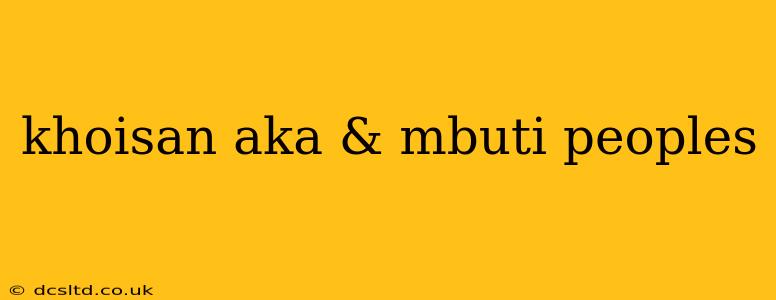The Khoisan and Mbuti peoples represent two distinct groups of indigenous populations in Africa, both possessing unique histories, cultures, and genetic profiles. While geographically separated, they share some intriguing similarities, making a comparative study particularly revealing. This exploration will delve into their histories, languages, genetic makeup, and the challenges they face in the modern world.
What are the Khoisan people?
The Khoisan, also known as Khoikhoi and San, are hunter-gatherer groups primarily found in Southern Africa. The term "Khoisan" itself is a linguistic classification grouping together the languages spoken by these peoples. They are characterized by their unique physical traits, including epicanthic folds (similar to those found in East Asians) and the prevalence of steatopygia (fat accumulation on the buttocks and hips). Importantly, it's crucial to understand that "Khoisan" isn't a single, monolithic group. It encompasses numerous distinct ethnic groups with their own languages, customs, and histories.
The San, often referred to as "Bushmen," are widely considered the oldest inhabitants of Southern Africa, with genetic evidence suggesting their presence on the continent for tens of thousands of years. Their traditional way of life revolves around hunting and gathering, with a deep understanding of the natural environment. The Khoikhoi, on the other hand, historically practiced pastoralism, raising livestock like cattle and sheep.
What language do the Khoisan people speak?
Khoisan languages are unique and are often categorized as "click languages," characterized by the use of clicks made by articulating the tongue against the palate or teeth. These clicking sounds are not found in many other languages globally and represent a significant linguistic divergence. There's a rich diversity of click languages, not a single uniform language spoken by all Khoisan groups.
Who are the Mbuti people?
The Mbuti, also known as the Efe, are a Pygmy people inhabiting the Ituri Rainforest of the Democratic Republic of Congo. Unlike the Khoisan, they are primarily known for their forest-dwelling lifestyle. They are expert hunters and gatherers, deeply integrated with the rainforest ecosystem. The Mbuti are characterized by their relatively short stature compared to other groups in the region. Their culture is deeply entwined with their environment, with rich oral traditions and a strong emphasis on community and cooperation.
What is the genetic relationship between the Khoisan and Mbuti?
Genetic studies have provided valuable insights into the ancestry of both the Khoisan and Mbuti peoples. While distinct in many ways, both groups exhibit genetic lineages that are among the oldest in Africa, reflecting a long history of separation and adaptation to their respective environments. Some genetic markers suggest ancient connections, but the exact nature of the relationship between the Khoisan and Mbuti is still a subject of ongoing research.
Are Khoisan and Mbuti the oldest people?
While it's inaccurate to label either group definitively as "the oldest people," genetic evidence strongly suggests that both the Khoisan and Mbuti represent lineages with deep roots in Africa, tracing back tens of thousands of years. However, the concept of “oldest” is complex and depends on how we define “people” and "oldest." The evolution of human populations is intricate and far from a simple linear progression.
What are the major challenges faced by the Khoisan and Mbuti peoples today?
Both the Khoisan and Mbuti face numerous challenges in the modern world. These include:
- Land dispossession: Loss of traditional lands due to encroachment from farming, mining, and other development activities.
- Marginalization and discrimination: Facing social and economic marginalization stemming from prejudice and lack of access to education and healthcare.
- Loss of traditional culture and language: The pressures of globalization threaten the preservation of their unique languages, cultural practices, and knowledge systems.
- Impact of climate change: Changes in weather patterns and resource availability are adding further strain to their already vulnerable communities.
- Conflict and instability: In many regions where they live, political instability and conflict create further hardship.
Understanding the historical contexts, unique cultures, and contemporary challenges of the Khoisan and Mbuti peoples is essential for promoting their rights, protecting their heritage, and ensuring their sustainable future. Ongoing research and collaborative efforts are crucial to address the complex issues faced by these remarkable indigenous groups.
